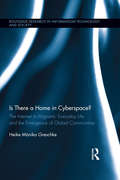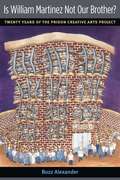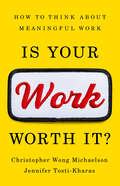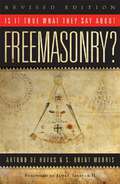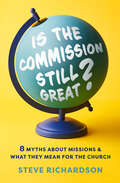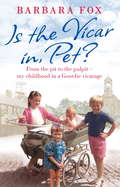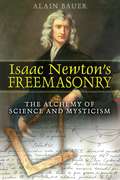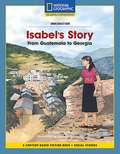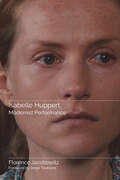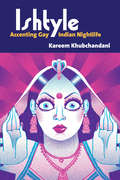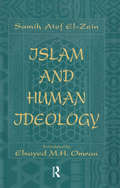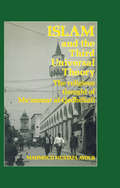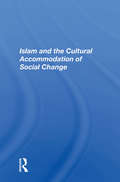- Table View
- List View
Is There a Home in Cyberspace?: The Internet in Migrants' Everyday Life and the Emergence of Global Communities (Routledge Research in Information Technology and Society)
by Heike Mónika GreschkeHow is global togetherness possible? How does the availability of the Internet alter migrants' everyday lives and senses of belonging? This book introduces an 'alien people' inhabiting a specific common virtual space in the World Wide Web, while the members of this space - most of them ethnic Paraguayans - are physically located in many different parts of the world. By developing an innovative and 'uniquely adequate' set of research methods, the author explores the interrelation of media and migration practices in their own right and sheds light not only on the living conditions of contemporary (Paraguayan) migrants, but also on emerging global forms of living together. The concentration on a single case facilitates an in-depth understanding of contemporary migration practices, cultural meanings of digital media and senses of belonging. The book discusses empirical data, methods and theoretical concepts in a reflexive writing style, allowing readers to follow the research process, and to learn from its choices and challenges which are rarely visible in most research reports. The reflexive research procedure contributes not only to the understanding of social realities in the light of globalization, but also to an advancement of sociological methods and concepts for researching social phenomena in global landscapes and mediatization.
Is This Wi-Fi Organic?: A Guide to Spotting Misleading Science Online
by Dave FarinaHow to separate facts from fake science in the Disinformation Age: “Cuts through the chaos . . . sure to keep you laughing while also keeping you thinking.” —Matt Candeias, PhD, author of In Defense of PlantsWe live in an era when scams, frauds, fake news, fake stories, fake science, and false narratives are everywhere. Fortunately, you don’t need a BS in Science to spot science BS. This guide from educator Dave Farina, aka YouTube’s Professor Dave, is a playful yet practical investigation of popular opinions and consumer trends that permeate our society. Shoppers insist on “organic” everything even if they’re unable to define the term. Healers and quantum mystics secure a foothold alongside science-based medicine in an unregulated and largely unchallenged landscape. Misleading marketing is used to sell you products and services that range from ineffectual to downright dangerous.With the knowledge gained from Dave Farina’s simple explanations of basic scientific principles, you can learn to spot misinformation and lies on the internet before they spot you. Learn the real science behind such semi-controversial subjects as drugs, vaccines, energy, and biotechnology—and most importantly, arm yourself with the critical-thinking skills everyone needs in a world filled with nonsense.“Scientific literacy is our best defense in an age of increasing disinformation.” —Kellie Gerardi, aerospace professional and author of Not Necessarily Rocket Science
Is William Martinez Not Our Brother?: Twenty Years of the Prison Creative Arts Project
by Buzz AlexanderA prison arts program attempts to reverse the trends of incarceration in America
Is Your Work Worth It?: How to Think About Meaningful Work
by Jennifer Tosti-Kharas Christopher Wong MichaelsonWhat is work that&’s worth doing in a life worth living? A revealing exploration of the questions we ask and the stories we tell about our work. According to recent studies, barely a third of American workers feel &“engaged&” at work, and for many people around the world, happiness is lowest when earning power is highest. After a global pandemic that changed why, how, and what people do for a living, many workers find themselves wondering what makes their daily routine worthwhile. In Is Your Work Worth It?, two professors – a philosopher and organizational psychologist – investigate the purpose of work and its value in our lives. The book explores vital questions, such as: Should you work for love or money? When and how much should you work? What would make life worth living in a world without work? What kind of mark will your work leave on the world? This essential book combines inspiring and harrowing stories of real people with recent scholarship, ancient wisdom, arts, and literature to help us clarify what worthy work looks like, what tradeoffs are acceptable to pursue it, and what our work can contribute to society.
Is it (Still) Mostly Fiscal? Determinants of Sovereign Spreads in Emerging Markets
by Sanjeev Gupta Emanuele Baldacci Amine MatiA report from the International Monetary Fund.
Is it True What They Say About Freemasonry?
by S. Brent Morris Arturo de HoyosFor as long as there have been Freemasons, there has been a calculated effort to disparage and their practices. In this insightful text, masons de Hoyos and Morris explore the origins of the anti-Masonic mindset and delve into the falsehoods on which critics have based these perennial sentiments. Confronting opponents one at a time, the authors methodically debunk the myths that have surrounded Freemasonry since its establishment, investigating the motives and misconceptions that derive antagonists to spread deceit about Masonic traditions.
Is the Commission Still Great?: 8 Myths About Missions And What They Mean For The Church
by Steve RichardsonIs the Death Penalty Dying?
by Austin Sarat Jürgen MartschukatThis volume of "Studies in Law, Politics, and Society" presents a unique special issue "Is the Death Penalty Dying'. " Drawing together an array of distinguished scholars from political science, criminology, sociology, and law, this volume provides a compr
Is the PRGF Living Up to Expectations? An Assessment of Program Design
by Sanjeev Gupta Shamsuddin Tareq Gabriela Inchauste Mark Plant Benedict Clements Thomas Dorsey Emanuele Baldacci Nita ThackerThe creation of the Poverty Reduction and Growth Facility (PRGF) in late 1999 represented the culmination of more than two years of internal and external reviews and IMF policy discussions on the assessment and transformation of the Enhanced Structural Adjustment Facility (ESAF). The PRGF now functions as the IMF's principal instrument to support low-income countries in implementing their poverty reduction strategies. Targets and policies embodied in PRGF-supported programs should emerge from the country's own poverty reduction strategy, as laid out in its PRSP or Interim PRSP (I-PRSP). Key features which PRGF programs have in common were identified as follows: Broad participation and greater ownership; Embedding of the PRGF in the overall strategy for growth and poverty reduction; Budgets that are more pro-poor and pro-growth; Appropriate flexibility in fiscal targets ensured; More selective structural conditionality; Emphasis on measures to improve public resource management/accountability; Social impact analysis of major macroeconomic adjustments and structural reforms. The remainder of this paper provides an assessment of the extent to which PRGF-supported programs have implemented the individual key features.
Is the Vicar in, Pet?: From the Pit to the Pulpit – My Childhood in a Geordie Vicarage
by Barbara FoxIn the heart of Ashington - a bustling Geordie mining town - a handsome red-brick vicarage, surrounded by rambling gardens, stands proudly among the rows of terraced houses. It is the perfect place for playing games, keeping secrets and chasing the ghosts of previous occupants, and it will be nine-year-old Barbara's new home now that her father is to be vicar in this strange new place. In this charming memoir, Barbara Fox recalls a childhood where parishioners knocked on the door at all hours of the day and night, and where no one batted an eye at the collection of waifs and strays who regularly joined the family at the kitchen table. This is a warm-hearted, classic tale of family, community and the unforgettable thrill of childhood adventure.
Is the Vicar in, Pet?: From the Pit to the Pulpit – My Childhood in a Geordie Vicarage
by Barbara FoxIn the heart of Ashington - a bustling Geordie mining town - a handsome red-brick vicarage, surrounded by rambling gardens, stands proudly among the rows of terraced houses. It is the perfect place for playing games, keeping secrets and chasing the ghosts of previous occupants, and it will be nine-year-old Barbara's new home now that her father is to be vicar in this strange new place. In this charming memoir, Barbara Fox recalls a childhood where parishioners knocked on the door at all hours of the day and night, and where no one batted an eye at the collection of waifs and strays who regularly joined the family at the kitchen table. This is a warm-hearted, classic tale of family, community and the unforgettable thrill of childhood adventure.
Isaac Newton's Freemasonry: The Alchemy of Science and Mysticism
by Alain BauerAn exploration of how modern Freemasonry enabled Isaac Newton and his like-minded contemporaries to flourish • Shows that Freemasonry, as a mystical order, was conceived as something new--an amalgam of alchemy and science that had little to do with operative Freemasonry • Reveals how Newton and his friends crafted this “speculative,” symbolic Freemasonry as a model for the future of England • Connects Rosslyn Chapel, Henry Sinclair, and the Invisible College to Newton and his role in 17th-century Freemasonry Freemasonry, as a fraternal order of scientists and philosophers, emerged in the 17th century and represented something new--an amalgam of alchemy and science that allowed the creative genius of Isaac Newton and his contemporaries to flourish. In Isaac Newton’s Freemasonry, Alain Bauer presents the swirl of historical, sociological, and religious influences that sparked the spiritual ferment and transformation of that time. His research shows that Freemasonry represented a crossroads between science and spirituality and became the vehicle for promoting spiritual and intellectual egalitarianism. Isaac Newton was seminal in the “invention” of this new form of Freemasonry, which allowed Newton and other like-minded associates to free themselves of the church’s monopoly on the intellectual milieu of the time. This form of Freemasonry created an ideological blueprint that sought to move England beyond the civil wars generated by its religious conflicts to a society with scientific progress as its foundation and standard. The “science” of these men was rooted in the Hermetic tradition and included alchemy and even elements of magic. Yet, in contrast to the endless reinterpretations of church doctrine that fueled the conflicts ravaging England, this new society of Accepted Freemasons provided an intellectual haven and creative crucible for scientific and political progress. This book reveals the connections of Rosslyn Chapel, Henry Sinclair, and the Invisible College to Newton’s role in 17th-century Freemasonry and opens unexplored trails into the history of Freemasonry in Europe.
Isabel's Story: From Guatemala To Georgia
by Julia SchafferA family from Guatemala finds peace and a new life in Georgia. Spanning different regions, time periods, and ethnic groups, this series of fictional accounts help students explore the American immigrant experience. Readers are introduced to some of the reasons why people move to a new land, and they experience the triumphs and tragedies of families who risked the journey to America.
Isabelle Huppert, Modernist Performance
by Florence JacobowitzIsabelle Huppert's modernist performance style illustrated through detailed readings of key films, demonstrating her immense social impact. Isabelle Huppert's oeuvre constitutes perhaps the most significant feminist body of work to have emerged in the wake of the second wave of the women's movement, a period of intense social change. The emphasis on autonomy, or the "anti-victim," which comes to define Huppert's persona, is supported by a modernist style of performance. Huppert's refusal to surrender herself to the viewer through a character one fully knows disrupts the expectations of identification, inviting a distinctive approach to her characters. By creating a character informed by who she is, Huppert signals a process usually kept invisible. Huppert's performances invite an active form of critical reading, directing one to fill in gaps and consider the character in relation to the social world. The directors she works with welcome her collaboration; Huppert's performance, in conjunction with the mise-en-scène, generic conventions, and the film in its totality, creates the "meaning" of the film. Thus, Isabelle Huppert, Modernist Performance demonstrates its premise through close readings considering how performance must be read in tandem with the whole.
Ishi's Brain: In Search of Americas Last "Wild" Indian
by Orin StarnFrom the mountains of California to a forgotten steel vat at the Smithsonian, this "eloquent and soul-searching book" (Lit) is "a compelling account of one of American anthropology's strangest, saddest chapters" (Archaeology). After the Yahi were massacred in the mid-nineteenth century, Ishi survived alone for decades in the mountains of northern California, wearing skins and hunting with bow and arrow. His capture in 1911 made him a national sensation; anthropologist Alfred Kroeber declared him the world's most "uncivilized" man and made Ishi a living exhibit in his museum. Thousands came to see the displaced Indian before his death, of tuberculosis. Ishi's Brain follows Orin Starn's gripping quest for the remains of the last of the Yahi.
Ishtyle: Accenting Gay Indian Nightlife (Triangulations: Lesbian/Gay/Queer Theater/Drama/Performance)
by Kareem KhubchandaniIshtyle follows queer South Asian men across borders into gay neighborhoods, nightclubs, bars, and house parties in Bangalore and Chicago. Bringing the cultural practices they are most familiar with into these spaces, these men accent the aesthetics of nightlife cultures through performance. Kareem Khubchandani develops the notion of “ishtyle” to name this accented style, while also showing how brown bodies inadvertently become accents themselves, ornamental inclusions in the racialized grammar of desire. Ishtyle allows us to reimagine a global class perpetually represented as docile and desexualized workers caught in the web of global capitalism. The book highlights a different kind of labor, the embodied work these men do to feel queer and sexy together. Engaging major themes in queer studies, Khubchandani explains how his interlocutors’ performances stage relationships between: colonial law and public sexuality; film divas and queer fans; and race, caste, and desire. Ultimately, the book demonstrates that the unlikely site of nightlife can be a productive venue for the study of global politics and its institutional hierarchies.
Isis: Islam Tools or The West Mercenaries
by Rosaria Tirrito Rossana CarneThis short treatise offers an overview of one of the most controversial movements and terrorist groups of the XXI Century, analyzing the infamous ISIS from its creation to the Paris attacks of Friday, November 13th, 2015. Here, one may find a sharp analysis of the birth and the history of the Islamic State, the origin and ideology of the Wahhabi current, its geopolitical evolution from a small group of troops to a modern State, without neglecting the phenomenon of the Arab Springs. Eventually, the most important events that have recently shocked the West are examined, suggesting the idea that ,perhaps, they contain something much darker than ordinary people may have imagined.
Islam & Human Ideology
by Samih Atef El-ZeynThis book sets forth the concepts relating to viewpoints concerning life. It identifies the principle behind these concepts and traces each such concept back to its source and origin, whether it emanates from the capitalist-democratic, communist-socialist, or Islamic principle. At the same time, it calls on people to establish bonds with one another, that is, intellectual bonds based on common principles. It also calls on them to distinguish one concept from another so that they can achieve the correct type of advancement and attain the exemplary ideology. First published in 1996. Routledge is an imprint of Taylor & Francis, an informa company.
Islam & Muslims: A Guide to Diverse Experience in a Modern World
by Mark SedgwickThe need to understand Islam and Muslims has never been greater, both because of conflicts that dominate the news and because of the increasing presence of Muslims in Western societies. There are hundreds of books that introduce the Western reader to Islam, and dozens of books that explore various Muslim societies (usually Arab ones). Islam & Muslims is the first to bring together both, explaining Islam in theory and in practice across the diverse Muslim world. Readers learn not just what Islam says about everything from the nature of God to marriage to prayer to politics, but also how individual Muslims (traditional or modern, devout or barely observant) apply teachings in everyday life.
Islam & Politics Afghanistan N
by Asta OlesenThe years 1978 and 1979 were dramatic throughout south and western Asia. In Iran, the Pahlavi dynasty was toppled by an Islamic revolution. In Pakistan, Zulfigar Ali Bhutto was hanged by the military regime that toppled him and which then proceeded to implement an Islamization programme. Between the two lay Afghanistan whose "Saur Revolution" of April 1978 soon developed into a full scale civil war and Soviet intervention. The military struggle that followed was largely influenced by Soviet-US rivalry but the ideological struggle followed a dynamic of its own. Drawing on a wide range of sources, including such previously unused archival material as British Intelligence reports, this is a detailed study of the Afghan debate on the role of Islam in politics from the formation of the modern Afghan state around 1800 to the present day.
Islam & The Third Universal Theory: The Religious Thought Of Mu'ammar Al-qadhdhafi (Routledge Library Editions: Islam, State And Society Ser.)
by Mahmoud Mustafa AyoubFirst published in 1987. Routledge is an imprint of Taylor & Francis, an informa company.
Islam And The Cultural Accommodation Of Social Change
by Bassam TibiTaking the perspective of anthropologist Clifford Geertz, Tibi re-approaches the problem of social change in Islam, arguing that religions represent cultural systems that both influence and are influenced by religion.
Islam And Violent Separatism
by Ashok SwainFirst published in 2007. Political demands for autonomy and independence by radicalized ethnic groups have recently intensi?ed as a result of the globalization of the post-Cold War world. In addition to facing the challenges posed by democratization, development and social movements, governments everywhere are striving to manage and contain ‘political Islam’. This is particularly true in Southeast Asia, where the violence and instability caused by Islamic radical groups have affected the consolidation of liberal democracy in the region. This volume examines the roles of the state and of civil society in three of the new democracies in Southeast Asia – the Philippines, Thailand and Indonesia. Focussing on the way these democracies address the in-creased threat posed to their nation-building projects by political Islam, Islam and Violent Separatism makes an important contribution to the understanding of new security risks, terrorism, democratic consolidation and contemporary Southeast Asian politics.
Islam Encountering Globalisation (Durham Modern Middle East and Islamic World Series #Vol. 2)
by Ali MohammadiOne of the greatest dilemmas facing Muslims today is the fact that Muslim culture is often seemingly incompatible with the culture of the modern Western world, and the features associated with it - technological progress, consumerism, and new electronic communication, all of which have the potential for a homogenizing effect on any culture. This book explores many key aspects of the globalisation process, discussing how Muslim countries are coping with globalisation, as well as considering how the West is responding to Islam.
Islam Explained: A Short Introduction to History, Teachings, and Culture
by Ahmad Rashid SalimA revealing guide to understanding the principles of IslamWith more than 1.8 billion followers worldwide, Islam is one of the world's largest religions, but it is also one that is poorly understood by many Americans. Islam Explained offers an informative overview of the faith, helping those who are new to Islam foster cultural awareness while also providing those already familiar with it the opportunity to deepen their understanding.Whether you are looking to expand your own knowledge of Islam or just better understand the practices of Muslim friends, coworkers, and neighbors, this concise and essential guide provides a solid foundation for future study and conversation.Islam Explained features:Easy-to-understand explanations—This book provides a complete overview ideal for those who are interested in Islam as a faith, a subject of study, and beyond.Historical contexts—Better understand the history of Islam, how the religion has evolved, and the ways that history has shaped the lives of Muslims.Beliefs and practices—Explore what it means to be a practicing Muslim, including the Five Pillars, laws, dress codes, and brief glimpses into how they vary between individual sects.Take yourself on a journey that will end in a better, more complete understanding of Islam.
